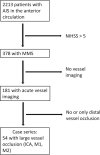Minor Stroke Syndromes in Large-Vessel Occlusions: Mechanical Thrombectomy or Thrombolysis Only?
- PMID: 28408627
- PMCID: PMC7960103
- DOI: 10.3174/ajnr.A5164
Minor Stroke Syndromes in Large-Vessel Occlusions: Mechanical Thrombectomy or Thrombolysis Only?
Abstract
While mechanical thrombectomy for large-vessel occlusions is now an evidence-based treatment, its efficacy and safety in minor stroke syndromes (NIHSS ≤ 5) is not proved. We identified, in our prospective data base, 378 patients with minor strokes in the anterior circulation; 54 (14.2%) of these had proved large-vessel occlusions. Eight of 54 (14.8%) were immediately treated with mechanical thrombectomy, 6/54 (11.1%) after early neurologic deterioration, and the rest were treated with standard thrombolysis only. Rates of successful recanalization were similar between the 2 mechanical thrombectomy groups (75% versus 100%). Rates of excellent outcome (modified Rankin Scale 0-1) were higher in patients with immediate thrombectomy (75%) compared with patients with delayed thrombectomy (33.3%) and thrombolysis only (55%). No symptomatic intracranial hemorrhage occurred in either group. These descriptive data are encouraging, and further analysis of large registries or even randomized controlled trials in this patient subgroup should be performed.
© 2017 by American Journal of Neuroradiology.
Figures
Comment in
-
Minor Stroke and Thrombolysis: What Is in the Pipeline?AJNR Am J Neuroradiol. 2017 Oct;38(10):E84-E85. doi: 10.3174/ajnr.A5298. Epub 2017 Jun 29. AJNR Am J Neuroradiol. 2017. PMID: 28663260 Free PMC article. No abstract available.
-
Reply.AJNR Am J Neuroradiol. 2017 Oct;38(10):E86. doi: 10.3174/ajnr.A5319. Epub 2017 Jun 29. AJNR Am J Neuroradiol. 2017. PMID: 28663261 Free PMC article. No abstract available.
References
MeSH terms
LinkOut - more resources
Full Text Sources
Other Literature Sources
Medical

